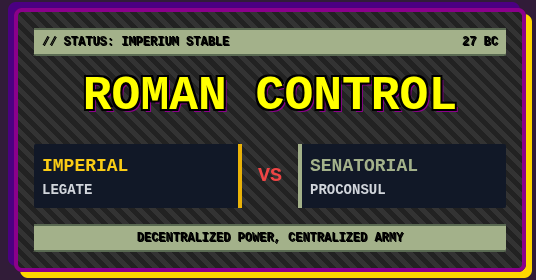Roman Provincial Control: Imperial vs. Senatorial
The administration of the Roman Empire, established most clearly under Augustus, utilized a critical administrative distinction: the division of provinces into Imperial and Senatorial categories. This separation was not merely bureaucratic; it was a cornerstone of Augustus's constitutional settlement, designed to maintain the illusion of Republican continuity while centralizing military and political power under the Emperor.
1. The Imperial Provinces: The Emperor's Domain
These provinces were governed directly by the Emperor through appointed officials known as legates (legati Augusti pro praetore). They were typically characterized by several key features:
- Military Presence: Imperial provinces included the vast, unsettled, or recently conquered border regions (e.g., Germania, Syria, Hispania Tarraconensis). They contained the majority of the Roman army.
- Governance: The Emperor needed direct control over these regions to command the legions and ensure frontier stability. This centralized military control was the true source of Imperial power.
- Finances: Revenues from these provinces flowed into the Emperor’s personal treasury (fiscus).
Significance: Any province experiencing frequent warfare or unrest, even if initially Senatorial, would be transferred to Imperial control. The presence of Roman legions was the defining trait of an Imperial province.
2. The Senatorial Provinces: The Senate's Administration
These were older, fully pacified provinces, considered settled and safe (e.g., Africa, Asia, Achaea). Their governance was entrusted to the Senate, continuing the Republican tradition.
- Military Absence: They maintained minimal, if any, military presence, reducing the potential for military commanders to launch civil wars.
- Governance: They were governed by proconsuls chosen by lot from among the former consuls and praetors of the Senate. Their term was typically only one year.
- Finances: Revenues from these provinces flowed into the public treasury (aerarium).
Example: A proconsul governing a Senatorial province like Asia served as the Roman head of government encountered by figures like the Apostle Paul (e.g., Sergius Paulus in Cyprus, an initial Senatorial province, Acts 13:7).
3. The Unique Case of Judea and Palestine
Judea, the homeland of the Jewish people, often demonstrates the flexibility of this system, reflecting its persistent instability. Although it was incorporated into the Empire, its status frequently changed:
- Imperial Status: Judea, while militarily important, was technically administered by a Prefect (like Pontius Pilate) or later a Procurator under the Imperial province of Syria. This setup was chosen specifically because of the continuous unrest and the need for frequent military intervention, placing command directly under the Emperor's authority.
- Brief Senatorial Periods: At certain times, Judea was returned to client kings (like Herod Agrippa I) or experienced short periods of administrative shuffling, but the necessary Imperial military presence remained the dominant factor in its control, highlighting its volatile status within the Roman peace (Pax Romana).

